

Breakfast, Lunch, and Dinner // Supercut. Walt peregoy - Google Search. Classic Video Game Sounds Explained by Experts (1972-1998) Onvolledigheidsstellingen van Gödel. Animated GIFs Illustrating the Art of Japanese Wood Joinery. Japanese wood joinery dates back to the seventh century and is a craftsmanship technique that involves complicated, interlocking wooden joints that form bonds without the use of nails, screws or adhesives.

Even until recent times when carpentry books began to be published, mastery of these woodworking techniques remained the fiercely guarded secret of family carpentry guilds. Several years ago a young Japanese man working in automobile marketing discovered one such book. Quipu - Wikipedia. Quipus, sometimes known as khipus or talking knots,[1] were recording devices historically used in a number of cultures and particularly in the region of Andean South America.[2] Similar systems were used by the ancient Chinese and native Hawaiians,[3] though this article specifically deals with the most familiar Inca system, and knotted string records are often generically referred to in English as quipus after the Inca term.
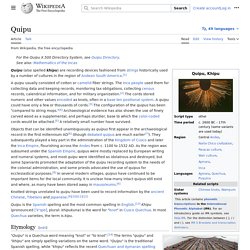
A quipu usually consisted of colored, spun, and plied thread or strings made from cotton or camelid fiber. For the Inca, the system aided in collecting data and keeping records, ranging from monitoring tax obligations, properly collecting census records, calendrical information, and military organization.[4] The cords contained numeric and other values encoded by knots in a base ten positional system. A quipu could have only a few or up to 2,000 cords.[5] The configuration of the quipus have also been "compared to string mops. Etymology[edit] Purpose[edit] Studio ponoc. Conlon nancarrow. A Brief History of Gore. A Love Letter to GOTHIC's Open World Design ➣ Game Design Focus - RagnarRox. Crazy Synthesizer Demo. The M16: a history in pictures. Why Biodiversity Is Good For The Economy.
Aesthetic Appreciation: Crash Course Philosophy #30. The baking soda and super glue trick. A LIVE 24x7 Interactive African Wildlife Safari. Andrew Malone: The Roman Domus as a Caribbean Urban Housing Solution. Lift. Residents living permanently in Japan's cyber-cafés - Lost in Manboo. ORBIS: The Stanford Geospatial Network Model of the Roman World. What Does Tomorrow Look Like? - How We Envision the Future - Extra Credits. 10 Bizarre Food Developments We May See In The Future. Food Man has always striven to expand his knowledge and the study of food is no exception.

Our current technology has enabled us to push the boundaries of food development further than ever before, and the entries on this list are just some of what we might see in the future. 10Headless Chicken Farms In 2012, Andre Ford, an architecture student at the UK Royal College Of Art, looked at the problems presently plaguing the broiler chicken industry and proposed the Center For Unconscious Farming as a solution. His objectives were to satisfy the demand for chicken meat while affording the animals more humane treatment. Laughter in animals. Laughter in animals other than humans describes animal behavior which resembles human laughter.

Numerous species demonstrate vocalizations similar to human laughter. A significant proportion of these are mammals, including non-human primates, which suggests that the neurological functions involved in expressing cheer occurred early in the process of mammalian evolution. [1] Non-human primates[edit] Chimpanzees, gorillas, bonobos and orangutans show laughter-like vocalizations in response to physical contact, such as wrestling, play chasing, or tickling. This is documented in wild and captive chimpanzees.
Hortum Machina, B, the garden that rolls across the city – We Make Money Not Art. Hortum Machina, B on Hampstead Road in London.
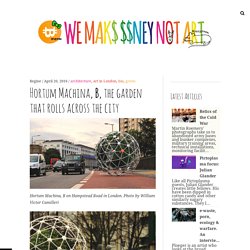
Photo by William Victor Camilleri Passersby reactions to Hortum Machina, B. Perceptual adaptation. Perceptual adaptation is a unique function of the brain that accounts for the differences viewed in the world, as it relates to the senses.
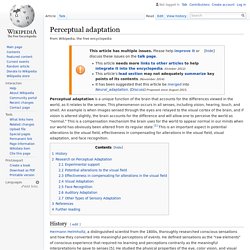
This phenomenon occurs in all senses, including vision, hearing, touch, and smell. An example is when images sensed through the eyes are relayed to the visual cortex of the brain, and if vision is altered slightly, the brain accounts for the difference and will allow one to perceive the world as "normal. " This is a compensation mechanism the brain uses for the world to appear normal in our minds when our world has obviously been altered from its regular state.[1] This is an important aspect in potential alterations to the visual field, effectiveness in compensating for alterations in the visual field, visual adaptation, and face recognition.
History[edit] The pleasure of poetic pattern - David Silverstein. Retrotechtacular: Examining Music in 1950’s Russia. If you had told 12-year-old me that one day I would be able to listen to pretty much any song I wanted to on demand and also pull up the lyrics as fast as I could type the artist’s name and part of the title into a text box, I would have a) really hoped you weren’t kidding and b) would have wanted to grow up even faster than I already did.

The availability of music today, especially in any place with first world Internet access is really kind of astounding. While the technology to make this possible has come about only recently, the freedom of music listening has been fairly wide open in the US. Rapping, deconstructed: The best rhymers of all time. MAMÁ -Javier Botet es Mamá (Movement Test) Architectures. As mentioned a while back, I’ve been trying to find a way to classify the numerous ‘Design with Intent’ and architectures of control examples that have been examined on this site, and suggested by readers.

Since that post, my approach has shifted slightly to look at what the intent is behind each example, and hence develop a kind of ‘method’ for suggesting ‘solutions’ to ‘problems’, based on analysing hundreds of examples. I’d hesitate to call it a suggestion algorithm quite yet, but it does, in a very very rudimentary way, borrow certain ideas from TRIZ*. Below is a tentative, v.0.1 example of the kind of thought process that a ‘designer’ might be led through by using the DwI Method. I’ve deliberately chosen an common example where the usual architectures of control-type ‘solutions’ are pretty objectionable. Other examples will follow. Basics of the DwI Method, v.0.1. The Woobie. A "woobie" is a name for any type of character who makes you feel extremely sorry for them.
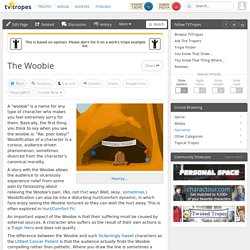
Basically, the first thing you think to say when you see the woobie is: "Aw, poor baby! " Woobification of a character is a curious, audience-driven phenomenon, sometimes divorced from the character's canonical morality. A story with the Woobie allows the audience to vicariously experience relief from some pain by fantasizing about relieving the Woobie's pain. (No, not that way! Well, okay, sometimes.) Wacky Races - See-Saw to Arkansas Clip. My Bed. My Bed is a work by the English artist Tracey Emin.
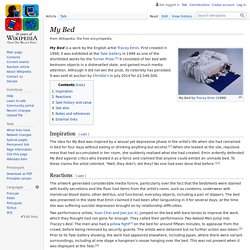
First created in 1998, it was exhibited at the Tate Gallery in 1999 as one of the shortlisted works for the Turner Prize.[1] It consisted of her bed with bedroom objects in a dishevelled state, and gained much media attention. Although it did not win the prize, its notoriety has persisted. It was sold at auction by Christie’s in July 2014 for £2,546,500. Inspiration[edit] The idea for My Bed was inspired by a sexual yet depressive phase in the artist's life when she had remained in bed for four days without eating or drinking anything but alcohol.[2] When she looked at the vile, repulsive mess that had accumulated in her room, she suddenly realised what she had created. [edit] Readings & Flowcharts. Search. Hoe het is om te leven met kleptomanie. Alle illustraties door Michael Dockery. Grid Corrections (a one minute)
10 Lesser Known or Used Forms of Government. Parable of the Invisible Gardener. The Parable of the Invisible Gardener is a tale told by John Wisdom. It was later developed in the university debate by Antony Flew, who made a few changes such as changing the gardeners to explorers. It is often used to illustrate the perceived differences between assertions based on faith and assertions based on scientific evidence, and the problems associated with unfalsifiable beliefs.
The main point of the parable is that religious believers do not allow anybody to "falsify" their assertions, instead they simply change their beliefs to suit the questioner. The art of the metaphor - Jane Hirshfield. To explore metaphors more fully on your own, there are three directions you can go. The first is simply to start noticing whenever you meet one. Jane Hirshfield slipped metaphors into many of the things she said in this lesson. You might listen to it again and make a list of some of the metaphors she used along the way, without pointing out that they were metaphors. Then go to any random web blog or newspaper or magazine article and just start reading until you’ve found a half dozen metaphors. Sometimes there will be many right away, other times there could be none at all. A second direction to explore metaphors further is to practice inventing metaphors yourself. A third way to learn more about metaphor is to read about it directly. A few specific resources:
Draag je lievelingsboek voor altijd bij je met deze sieraden van papier. E. List of cognitive biases. Cognitive biases are tendencies to think in certain ways that can lead to systematic deviations from a standard of rationality or good judgment, and are often studied in psychology and behavioral economics. There are also controversies as to whether some of these biases count as useless, irrational or whether they result in useful attitudes or behavior.
For example, when getting to know others, people tend to ask leading questions which seem biased towards confirming their assumptions about the person. This kind of confirmation bias has been argued to be an example of social skill: a way to establish a connection with the other person.[7] United States foreign aid. United States foreign aid is aid given by the United States government to other governments. Budget of NASA. As a federal agency, the National Aeronautics and Space Administration (NASA) receives its funding from the annual federal budget passed by the United States Congress. The following charts detail the amount of federal funding allotted to NASA each year over its past sixty-year history (1958–2018) to operate aeronautics research, unmanned and manned space exploration programs. The Modular Body.
List of cognitive biases. STRANGETHINK (@Strangethink23) Humanitarians of Tinder. Amy Whittle. Oklo, the Two Billion Year Old Nuclear Reactor. Shadow person. Internetten doe je in Cuba met z'n allen. Butterflies Remember What They Learned as Caterpillars. On the Phenomenon of Bullshit Jobs - STRIKE!
Ever had the feeling that your job might be made up? THE PIGEONHOLE MAN & THE DEAF (De Hokjesman, afl. De Doven - english subs) Why the modern bathroom is a wasteful, unhealthy design. For centuries, the people of London and other big cities got their cooking and washing water from rivers or wells, limiting their consumption to pretty much what they could carry. Boa mistura rejuvinate mexican neighborhood with otomi art. Apr 24, 2014. The Gentlemen of Bakongo And Their Cult Of Elegance. De Urban Campsite, een reizende camping waar kamperen en kunst samenkomen. Dutch Profiles. Extra Credits - MMO Economies - How to Manage Inflation in Virtual Economies. SkywayMyWay - Minneapolis Skyway Map. 10 Of The World's Most Unusual Towns. 10 Bizarre Hypothetical Forms Of Government. The Railroad Journey and the Industrial Revolution: Crash Course World History 214.
Extra Credits: Gamification. Democracy, Authoritarian Capitalism, and China: Crash Course World History 230. Smallest organisms. $9M Bitcoin haul buried in U.K. rubbish tip - Nov. 29, 2013. The Firebombing of Tokyo. List of largest buildings in the world. Krakatoa. List of longest-living organisms. Magnetic movie. How to Make an Attractive City. Why Some Countries Are Poor and Others Rich. Selective breeding of plants. 10 Theological Explorations Of Futuristic Ideas. 10 Thought Phenomena That Cause Us To Make Bad Decisions. Weather Man: Life at a Remote Russian Weather Station. Continuing Days in the Life of a Financial Adviser. List of weather records.
Lists of extreme points. Extremes on Earth. Largest organisms. Feedback loops: How nature gets its rhythms - Anje-Margriet Neutel. Natural nuclear fission reactor. A guide to the energy of the Earth - Joshua M. Sneideman. Nietzsche: Genealogy of Morals. 9 Ways Altruism Is Destroying The World. 10 Amazing Human Behaviors In Apes And Monkeys. Labyrint: Taal bepaalt. 10 Massive Things We Built And Then Destroyed. 10 Bizarre Scientific Art Projects. 15 Giant Monsters That Lived Alongside Humans. 10 Horrible Facts About Charities. The sound of empty space. China Archives - Art and design inspiration from around the world - CreativeRootsArt and design inspiration from around the world. Kevin Kan.